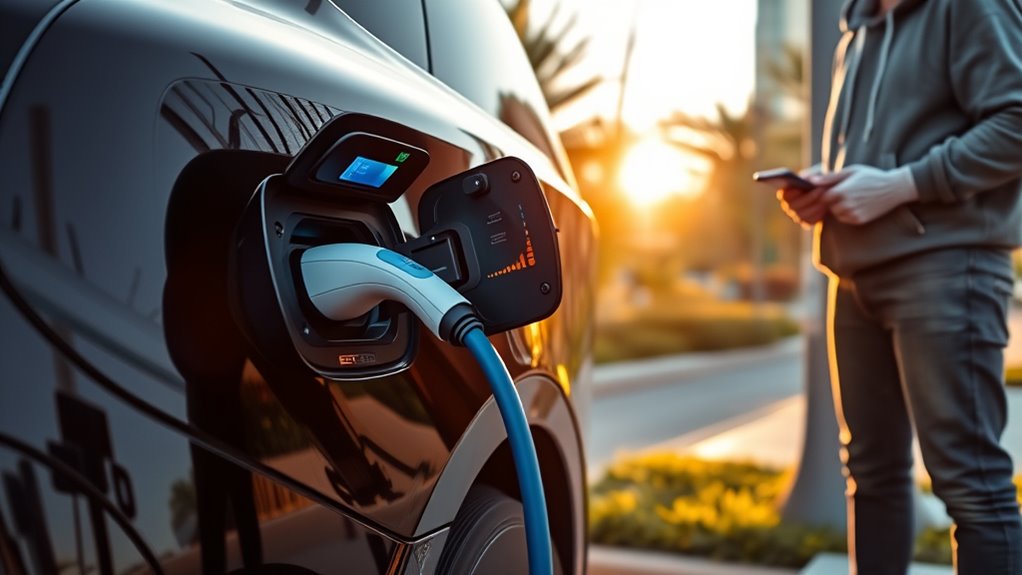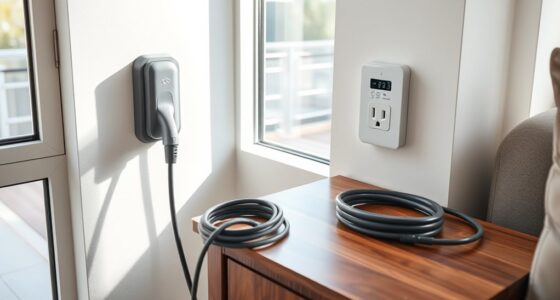To keep your electric vehicle in top shape, focus on battery care by charging between 20-80%, avoiding frequent fast charges, and monitoring temperature. Regularly check and top off fluids like coolant and brake fluid, and keep an eye on tire pressure and wear. Schedule inspections every 12,000-15,000 miles to catch issues early. Using proper charging habits and maintenance tips can prolong your EV’s lifespan—continue explore for more expert advice.
Key Takeaways
- Keep your EV battery charge between 20% and 80% to prolong lifespan.
- Regularly check and maintain fluid levels, including coolant and brake fluids.
- Inspect brakes and tires every 6,000 to 10,000 miles for optimal safety.
- Schedule annual or 12,000-15,000 mile mechanical inspections for early issue detection.
- Use Level 2 chargers at home and limit fast charging to long trips to reduce battery wear.
Prioritize EV Battery Care
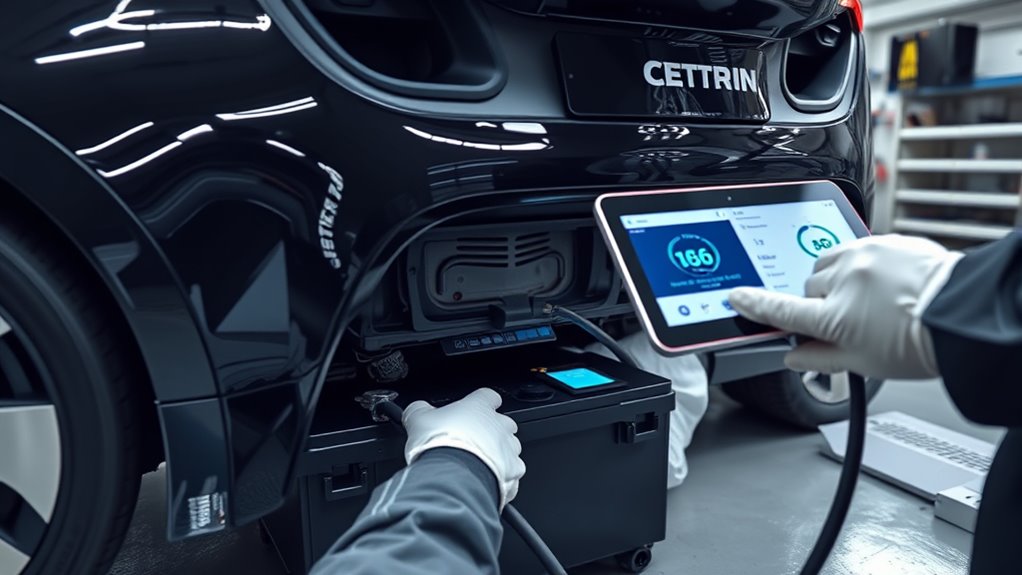
To keep your electric vehicle’s battery healthy and long-lasting, it’s essential to prioritize proper battery care. Your EV battery, especially the battery pack’s, benefits from maintaining ideal charge levels—aim for between 20% and 80%. Charging your battery to 100% or letting it drop below 20% accelerates battery degradation and shortens its lifespan. Regularly monitor and maintain the cooling system and temperature control features to prevent overheating or cold damage. During extreme weather, park in covered, temperature-controlled areas to protect the battery. Use slow, home-based chargers for daily charging instead of fast chargers, which can cause faster wear over time. Proper battery maintenance ensures your EV batteries stay efficient and durable for years to come. Additionally, staying informed about battery technology advancements can help you make better decisions about upgrades and maintenance. Being aware of storage practices when the vehicle is not in use can also significantly impact battery longevity and performance. Incorporating appropriate charging habits can further extend the lifespan of your EV’s battery and optimize its overall performance.
Keep Your Vehicle’s Fluids in Check
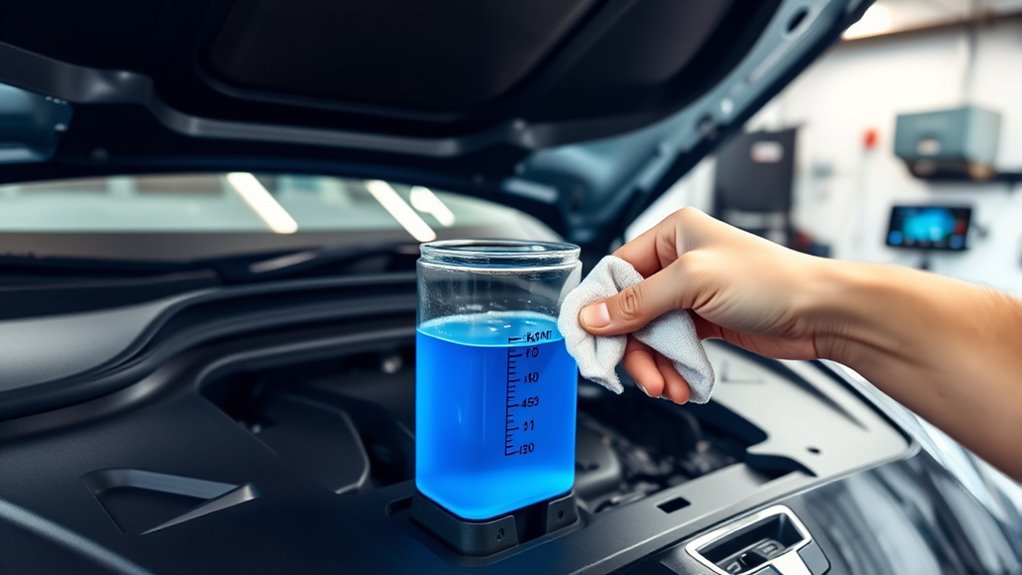
Keeping your vehicle’s fluids in check is essential for safe and reliable operation. Regular maintenance involves monitoring fluid levels, including brake fluid, windscreen wiper fluid, and coolant. For your EV, fluid inspection is crucial, especially in high-voltage cooling systems, to prevent overheating and damage. Check coolant or thermal management fluids per the manufacturer’s recommended schedule and top off as needed. Although EVs don’t require oil changes like traditional vehicles, maintaining proper lubricant levels in gear reduction transmissions or gearboxes is vital to avoid mechanical issues. Always follow your owner’s manual for specific intervals on fluid replacements and inspections. Staying proactive with fluid maintenance ensures your EV operates smoothly, safely, and efficiently over time. Cookies can enhance your browsing experience and provide important site functionalities, including monitoring maintenance reminders. Additionally, understanding electric vehicle components can help you better identify when maintenance is needed to prevent potential problems.
Maintain Brakes and Tire Health
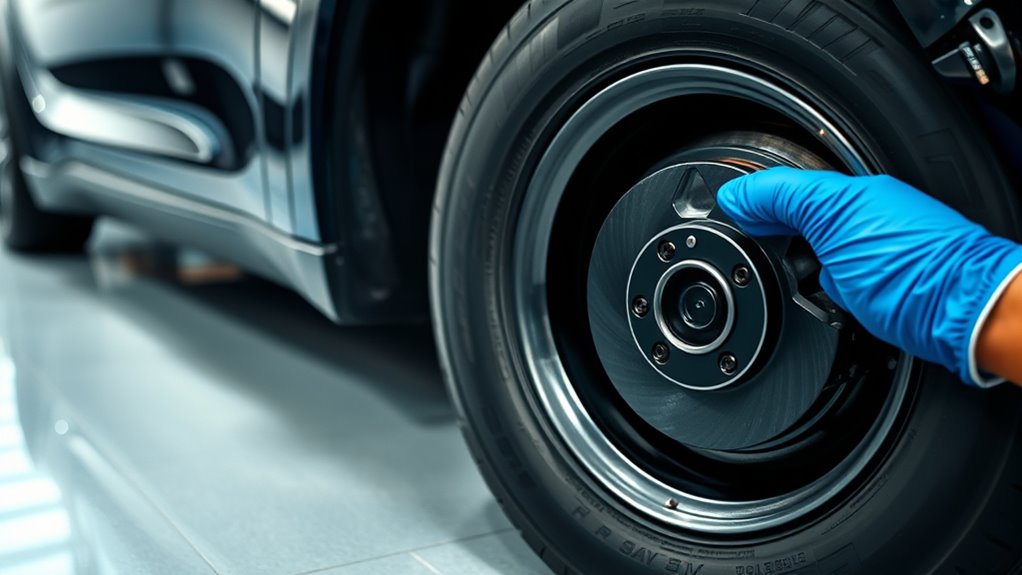
Regularly inspecting your brakes and tires is vital for safe and efficient EV driving. Check brake pads, rotors, and brake fluid every 3-5 years to prevent corrosion and guarantee braking performance. Tire checks include monitoring tire pressure, performing tire rotation every 6,000 to 10,000 miles, and inspecting tire wear to extend tire lifespan. EV tires tend to wear faster due to added weight, making routine inspections indispensable. Proper wheel alignment every 15,000 miles helps prevent uneven tire wear and maintains handling. Use the table below to understand key maintenance tasks:
| Task | Recommended Interval | Purpose |
|---|---|---|
| Brake fluid replacement | Every 3-5 years | Prevent corrosion |
| Tire rotation | Every 6,000-10,000 miles | Ensure even tire wear |
| Wheel alignment | Every 15,000 miles | Improve safety and tire lifespan |
Maintaining proper tire pressure and tire wear monitoring and ensuring timely replacements are also crucial for optimal vehicle performance and safety. Additionally, understanding tire wear patterns can help identify alignment or suspension issues early. Regularly checking tire pressure helps prevent uneven wear and improves overall efficiency. Being aware of performance metrics can assist in identifying when maintenance is needed before issues become severe.
Schedule Regular Mechanical Inspections

Scheduling your EV’s mechanical inspections every 12,000 to 15,000 miles or once a year guarantees that key components like the battery, cooling systems, brakes, and tires stay in excellent shape. During these inspections, technicians check battery health, tire condition, fluid levels, and brake components to prevent unexpected failures. Regularly monitoring fluid levels, such as coolant and brake fluid, helps maintain the vehicle’s systems and prolong lifespan. Additionally, staying informed about your vehicle’s maintenance needs can help you plan for upcoming service requirements and avoid unexpected breakdowns. Incorporating custom tuning options from reputable providers can also optimize your EV’s performance and efficiency over time. Professional inspections also reveal early signs of wear or damage, reducing costly repairs and ensuring vehicle safety. Implementing regular quality checks aligns with industry best practices and ensures your EV remains reliable over time. Staying consistent with mechanical inspections is crucial for peak performance and peace of mind on the road. Moreover, leveraging AI-driven diagnostics can enhance the accuracy of maintenance assessments, leading to more proactive care. Engaging in preventative maintenance strategies helps catch issues early and extends the lifespan of your electric vehicle.
Use Proper Charging Practices
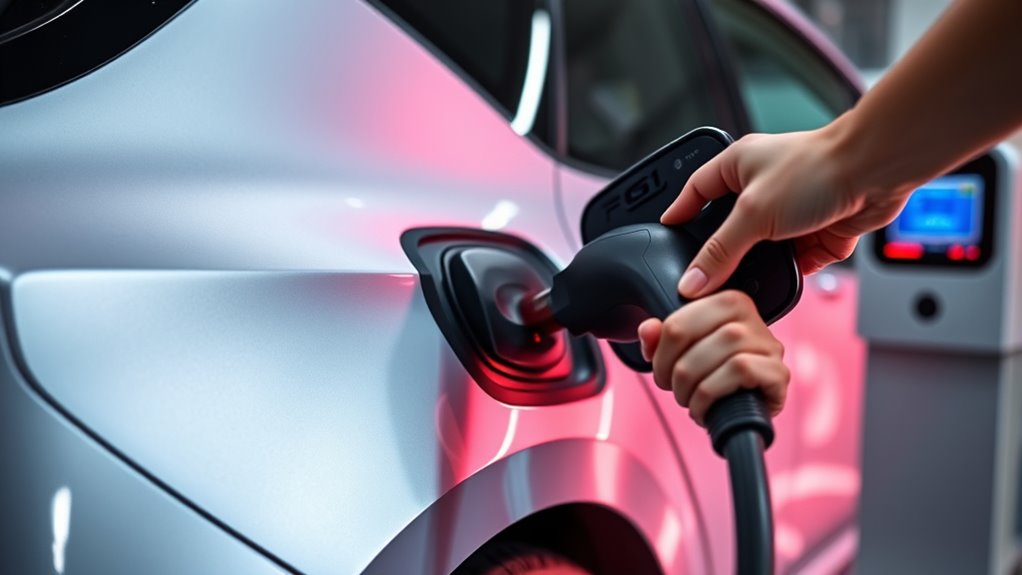
To maximize your EV’s battery lifespan, it’s important to adopt proper charging habits. Limit your daily charge level to 80-90%, which reduces battery degradation and preserves battery health. Use Level 2 chargers at home instead of fast charging for regular EV charging, as fast chargers accelerate battery wear over time. Reserve fast charging for long trips to prevent unnecessary capacity loss. Avoid fully discharging the battery below 20%, since deep discharges speed up battery aging. Always follow manufacturer recommendations to optimize your battery’s lifespan and performance. Being mindful of tuning practices can also help maintain your vehicle’s overall efficiency and longevity. Additionally, staying informed about automation advancements can help you better understand how emerging technologies might impact your vehicle’s maintenance and operation. Regularly monitoring battery health indicators is essential to identify potential issues early and ensure optimal performance, especially since battery management systems play a crucial role in maintaining battery longevity.
Frequently Asked Questions
What Is the 80% Rule for EV?
The 80% rule for EVs means you should aim to charge your battery up to only 80% of its capacity. By doing this, you reduce stress on the battery cells, which helps prevent premature wear. Many EVs automatically cap charging around 85-90% for this reason. Sticking to the 80% rule extends your battery’s lifespan, saves you money, and keeps your vehicle running smoothly longer.
How to Maintain an Electric Vehicle?
Did you know that improperly maintained EV batteries can lose up to 20% of their capacity in just five years? To keep your vehicle in top shape, avoid charging to 100% or letting it drop below 20%, and stay within the 20-80% charge range. Park in shaded areas during extreme weather, use Level 2 chargers, and schedule regular cooling system checks to extend your EV’s lifespan.
Should I Charge My EV to 80% EVery Night?
Charging your EV to 80% every night is a smart move. It helps reduce battery wear caused by full charges and minimizes stress on the battery, which can extend its lifespan. You don’t always need a full charge for your daily trips, so limiting to 80% balances your driving needs with battery health. Plus, it prevents unnecessary high-voltage exposure, keeping your EV’s battery healthier longer.
How Can I Maximize My EV Battery Life?
Think of your EV battery as a delicate garden that needs careful tending. To maximize its life, keep your charge between 20% and 80%, avoiding full charges or deep discharges. Skip fast chargers for daily top-ups, and park in shaded spots during extreme weather. Regularly monitor your charging habits and use your vehicle’s climate controls to maintain a healthy temperature, nurturing your battery’s longevity like a well-tended garden.
Conclusion
Think of maintaining your EV like tending a garden. With regular care—watering, pruning, and checking your plants—you make sure they thrive. Similarly, by prioritizing battery health, checking fluids, and scheduling inspections, your electric vehicle will run smoothly and last longer. Just as a well-tended garden blossoms beautifully, a well-maintained EV offers a reliable and enjoyable ride. Keep up with these simple tips, and your vehicle will serve you faithfully for miles to come.
